
Situation
With a count of two balls and two strikes, the batter for the home team is moved back off home plate by an inside pitch and in the process brings the bat forward and across the plate for an apparent strike three that ended the fourth inning of a Little League® (Major) Division baseball game. However, the umpire called “ball.” Not reacting to the umpire verbalizing a “ball” call, the catcher rolled the ball back toward the mound and the defense began to run off the field. In the meantime, the batter stays in the batter’s box, and the base runners on first base and second base advance one base. After the base runners move to second and third, the defensive manager asks for “time.” With base runners holding their current positions on base, the home plate umpire grants the manager’s “timeout” request. The coach declared the batter struck out swinging because he “offered at the pitch.” Should the home plate change his call from ball to strike, because the bat moved through the strike zone as the pitch went by?
Explanation
In the judgment of the home plate umpire, the batter was making an attempt to avoid being contacted by the pitch, and did not make an effort to contact the ball. The pitch was inside, off of the plate, resulting in a “ball” be called. Since the count did not yield an out or walk, and the pitch did not result in the play being declared “dead,” the base runners were at liberty to advance at their own risk. According to the current Little League Baseball® Official Regulations, Playing Rules, and Policies – Rule 2.00 – Strike: A legal pitch that meets any of these conditions – Is struck at by the batter and missed; Is not struck at, if any part of the ball passes through any part of the strike zone; Is fouled by the batter when there is less than two strikes; Is bunted foul (batter is out and ball is dead, if the batter bunts foul on the third strike); touches the batter’s person as the batter strikes at it (dead ball); touches the batter in flight in the strike zone; or becomes a foul tip ( ball is live and in play).
Note: This rule is applicable in all levels of Little League play.